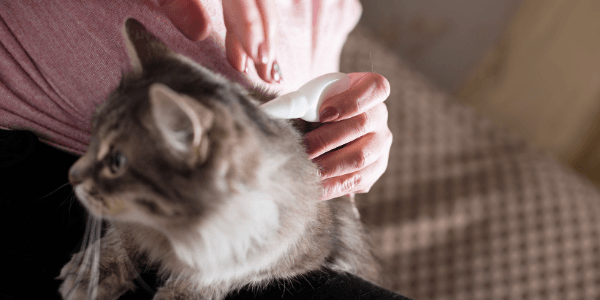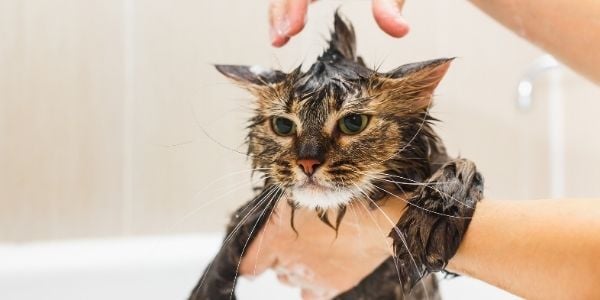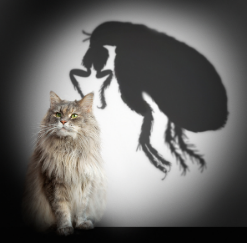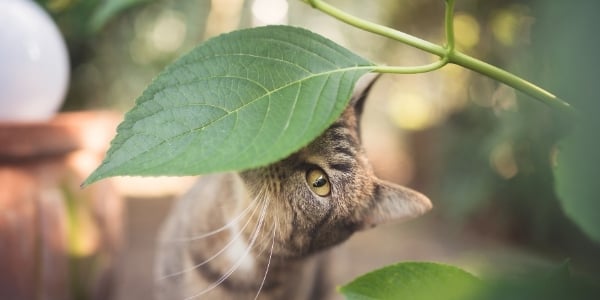 If you use flea and tick preventatives on your cat(s) or are thinking about doing so, then you need to know about pyrethroids, the danger these compounds pose to your feline friend, and how to avoid them when selecting the best products to prevent ectoparasites such as fleas and ticks.
If you use flea and tick preventatives on your cat(s) or are thinking about doing so, then you need to know about pyrethroids, the danger these compounds pose to your feline friend, and how to avoid them when selecting the best products to prevent ectoparasites such as fleas and ticks.
Did you know? Pyrethrin is the natural derivative of the chrysanthemum flower. Pyrethroid refers to the class of synthetic (stronger) derivatives of pyrethrins, such as permethrin.
Why Are Pyrethrin, Pyrethroids, and Permethrin Toxic to Cats?
Pyrethrins and the related — but more potent — chemically-derived pyrethroids are widely used insecticides in flea and tick prevention products for our pets (more commonly dogs).
They are also widely used around our homes in products such as bug sprays and for pest control. They kill insects by preventing their nervous system from functioning properly.
However, they are more typically used on dogs versus cats because cats are unable to process these compounds safely, as they lack the specific enzymes in their liver to do so.
Therefore, if your cat is exposed to these compounds, the result may be disastrous and/or even fatal. And your cat should be seen by a veterinarian immediately.
Ways Cats Are Exposed to Pyrethrins or Permethrins
Dog flea control products that contain pyrethroids are toxic to cats. Your cat may have been accidentally or intentionally given a dog flea treatment.
Some flea shampoos are toxic to cats. You may have unintentionally overused or overdosed ‘safe’ flea pyrethrin/permethrin-containing products.
Some flea/tick shampoos may contain very small amounts of pyrethrin compound – used as directed; these are considered typically safe. However, if the directions are not followed correctly, or the product is misused, the result can be disastrous.
Therefore, it is recommended to stick to shampoos that don’t contain these ingredients to prevent unintentional mistakes.
Dog pals. If you also have a dog that was treated with a pyrethrin/pyrethroid flea and tick preventative designed ONLY for dogs, such as a ‘spot on’ or topical preventative, and your cat was in close contact (e.g., grooming each other, sleeping next to each other, etc.), then your cat could have been exposed to the toxin.
These products can rub off on your cat and cause toxicity. The best idea is to separate your cat from your pooch until the product has dried, which is typically around 24 hours.
If you have a dog and cat in the same household, it is recommended that you discuss alternative preventatives with your dog's veterinarian to keep your cat safe.
Biting into or chewing on pyrethrin or permethrin-containing products if not stored correctly. This doesn’t just include flea and tick preventatives but insecticides that you may use on your garden or even bug sprays.

Serious Safety Note Regarding Certain Preventatives: Some dogs and cats may carry a genetic mutation (MDR1) that makes them sensitive to common medications including some preventatives. If your pet has this mutation, standard doses (or any use) could cause severe adverse reactions.
An MDR1 test can help your veterinarian tailor safe and effective treatments. Click here for a full list of medications for cats to be cautious about, a full list of medications for dogs to be cautious about, and to order tests.
The Signs of Pyrethrin and Pyrethroid Toxicity in Cats
Depending on how your cat was exposed to the toxin, signs of toxicity can happen within a few hours or may be delayed up to 24 hours after exposure. Cats exposed to a large amount of pyrethrin/pyrethroid-based insecticides will often have whole-body tremors. Other signs of pyrethrin/pyrethroid toxicity often include:
- Excessive salivation or drooling
- Vocalizing or crying
- Agitation or restlessness
- Vomiting
- Loss of coordination
- Difficulty jumping, standing, or walking
- Shaking, twitching, muscle tremors (often mistaken for seizures)
- Difficulty breathing
If left untreated, exposure or ingestion can be fatal to cats. In this video, you can see an example of tremors due to permethrin toxicity:
Treatment for Pyrethrin/Permethrin Toxicity
If the Toxicity Is Due to Skin Overexposure
There is no substitute for getting your cat to a veterinarian ASAP if they have been exposed to pyrethroids.
However, if you know your cat was exposed to this compound on their skin and if you feel comfortable, then prior to making a trip to your veterinarian, initial treatment should include bathing your cat.
Use a good grease-dissolving dish soap (most veterinarians use Dawn® dish soap), as it will bind to the product and help wash it off. This should reduce the amount of toxin absorbed and prevent further negative outcomes.
Some cats will require multiple baths. However, it is not recommended to continue bathing. You should get your cat to the veterinarian.
When bathing, be sure to always test the water temperature before placing your cat underneath the water. You don’t want to burn them or cause further issues with hypothermia if the water’s too cold.
Also, be extra careful to avoid getting water into your cat’s mouth and lungs during the bath, as your cat will be less able to protect their airway while experiencing tremors. There is no risk to you touching this product to your skin.
Therefore, gloves are not necessary, but always wash your hands after coming in contact with any insecticide.
Once you have bathed your cat, you should take them to a veterinarian for evaluation and further treatment.
Remember to bring the flea prevention product packaging with you. This will help your veterinarian with their diagnosis and treatment plan.

If the Toxicity Is Due to Ingestion of Pyrethrin/Pyrethroid
If your cat ate the toxin from grooming or snuggling with their favorite canine pal, bathing will do little to nothing to help. In such cases, skip the bath and head straight to the vet.
Additional treatment could include:
- Injectable medications to stop muscle tremors administered by your veterinarian
- IV fluid therapy in the hospital to restore and help maintain hydration to flush additional toxins out of your cat’s system
- IV lipid therapy in the hospital to help absorb and clear the toxin from their system
- Additional baths given at home, under the direction of your vet, even if your cat is no longer showing symptoms
Even with appropriate treatment, some affected cats can have long-term neurologic issues.
How to Protect Your Cat from Pyrethrin Toxicity
The frequency of cat pyrethrin/pyrethroid toxicity cases resulting from the unintentional (or intentional) application of a dog product to cats was so high that in 2010 the EPA improved product labeling rules for spot-on products for pets to help prevent these species mix-ups.
“New restrictions will be placed on these products, and pet owners need to carefully read and follow all labeling before exposing your pet to a pesticide,” the EPA’s Steve Owens said in a press release announcing the changes.
 To prevent pyrethrin/pyrethroid toxicity in your cat while still keeping them free of fleas and other parasites, take the following preventive measures:
To prevent pyrethrin/pyrethroid toxicity in your cat while still keeping them free of fleas and other parasites, take the following preventive measures:
- Read Up: Regardless of what product you use to kill and control fleas or other parasites, always follow label instructions and warnings.
- Check All Sources: Your dog’s flea control product might contain pyrethrin or a pyrethroid that your cat can ingest through grooming.
Some outdoor plant insecticides contain pyrethrins/pyrethroids, which can lead to toxicity if your cat goes outside and eats plants covered in those insecticides. - Research: Learn more about flea treatment and prevention, and be sure to discuss this important topic with your veterinarian. Flea prevention and control is about far more than just a monthly dose of medication in the summer months. The best flea prevention plan is year-round.
- Be Consistent: It’s of the utmost importance that you treat all of your pets and their environment throughout the year. Flea control isn’t just about maintaining your pets’ comfort (that’s definitely important) — fleas also spread some pretty nasty diseases to both pets and people.
Products That May Contain Pyrethrin
Flea preventatives, collars, foggers, and sprays
If you’re worried about pyrethrin toxicity and have opted to use a flea treatment for your cat that was not suggested or provided by your veterinarian, make sure you carefully read the labels. Check for the pyrethroid class of compounds.
When reading product labels, ensure that the compounds in a collective concentration fall below the typically safe level of 1%. Meaning you’ll need to calculate the total of all pyrethroid compounds in the ingredient list.
You can find a list of pyrethroid-containing compounds in this fairly comprehensive article on Wikipedia. Additionally, you can also find more information about pyrethrins and pyrethroids from the EPA.
Flea collars & shampoos
Some of these products may have pyrethroid compounds in them. That's because these products can be diluted or released slowly, which makes these compounds less toxic and dangerous when used correctly and according to label directions
However, there are often far safer options available to eliminate and control fleas on your cats and in their environment.
The safer alternatives are equally as effective, or in many cases more effective, than these pyrethrin/pyrethroid-based products:
It is recommended to use these following products on cats.
 Vet's Best Waterless Flea & Tick Cat Bath Foam
Vet's Best Waterless Flea & Tick Cat Bath Foam
 Vet's Best Plant-Based Formula Flea & Tick Cat Shampoo
Vet's Best Plant-Based Formula Flea & Tick Cat Shampoo
 Natural Chemistry Natural Flea Shampoo for Cats
Natural Chemistry Natural Flea Shampoo for Cats
Mosquito repellents
Some mosquito repellents are safe around or on dogs but not around cats, including DEET. Read more about mosquito repellents and their safety around pets.

Garden and Outdoor Pesticides
Many consumer pest control products you might use in your garden or yard contain pyrethrin or pyrethroids.
Do not let your cat come into contact with these outdoor insecticides — either through contact with treated plants or airborne spray. And if neighborhood outdoor cats might enter into your yard, consider using a non-pyrethrin/pyrethroid product.
This could also be a concern if you hire a pest control service, which may use a pyrethrin/pyrethroid-based insecticide in and around your home. Be sure to ask and specify that you need pet-safer methods and products to be used.



